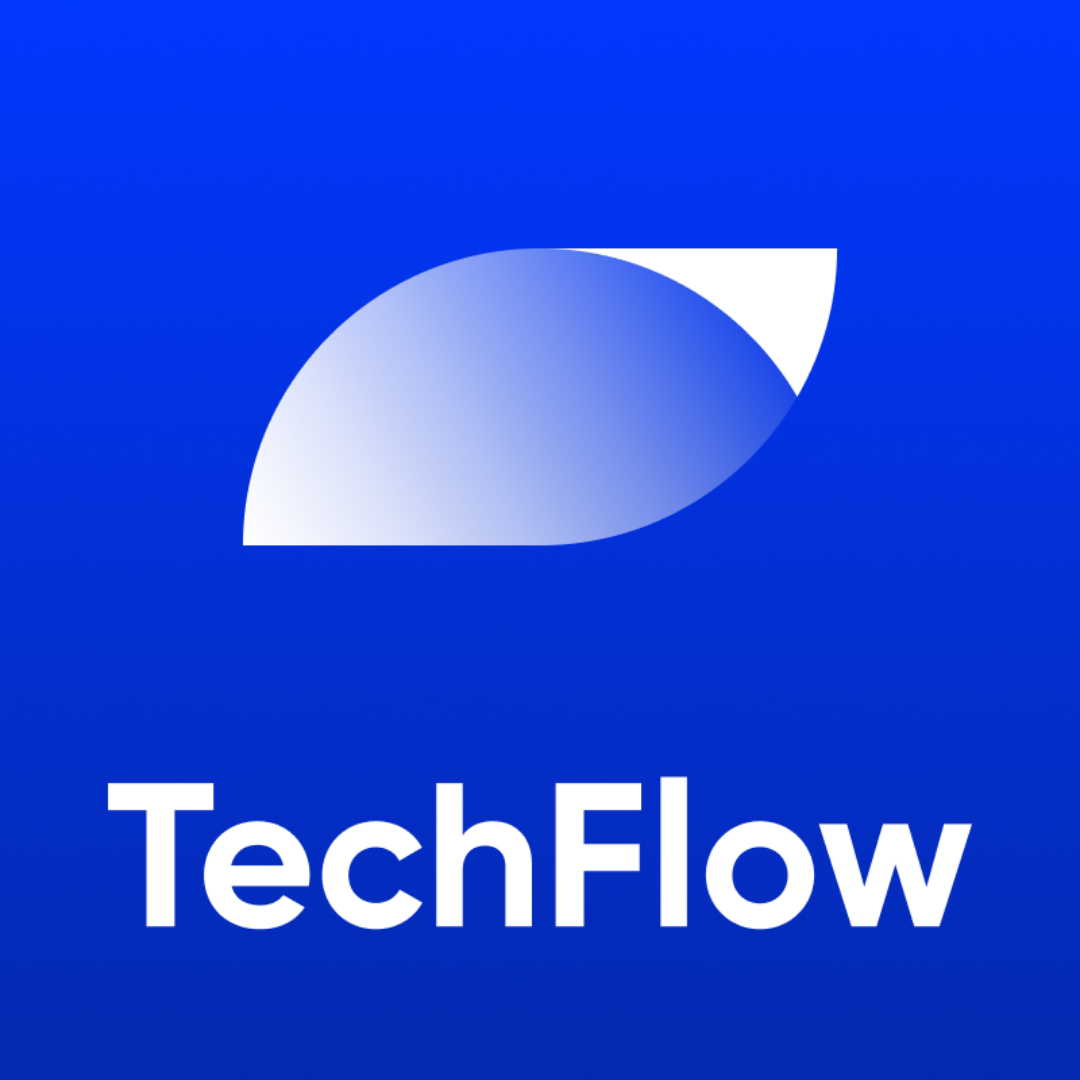When Steam meets Web3: How does 9bit make 3 billion gamers shareholders?
- 核心观点:9BIT通过代币化游戏消费重构价值分配。
- 关键要素:
- 消费即挖矿,积分兑换代币。
- 真实收入来自游戏销售与充值抽成。
- Spaces功能量化社区贡献激励。
- 市场影响:为GameFi提供可持续商业模式。
- 时效性标注:中期影响
Original author: TechFlow
Is GameFi dead?
Those once-frenzied "play-to-earn" projects have now become negative examples in the crypto world. Once the Ponzi scheme is labeled, it's hard to shake it off.
But is there really no way out for the combination of games and Web3?
In this cycle, those projects that are still working in this direction have taken another approach:
Instead of trying hard to create those crude blockchain games, it is better to let the already successful game economic system embrace Web3.
Outside the circle, Steam is integrating game distribution, purchase, management and community operations. Every year, its parent company Valve takes a 30% commission of every game transaction, while players get nothing except the game itself.
What if Steam's economic model was tokenized? What if every purchase not only gave you the game, but also a piece of ownership in the platform?
The idea of creating the "Steam of Web3" is being put into practice by a company you may have forgotten.
The9 Limited (NASDAQ code NCTY), a name that once left a mark in Chinese gaming history with "World of Warcraft", has returned with their 9BIT platform after a 15-year hiatus.
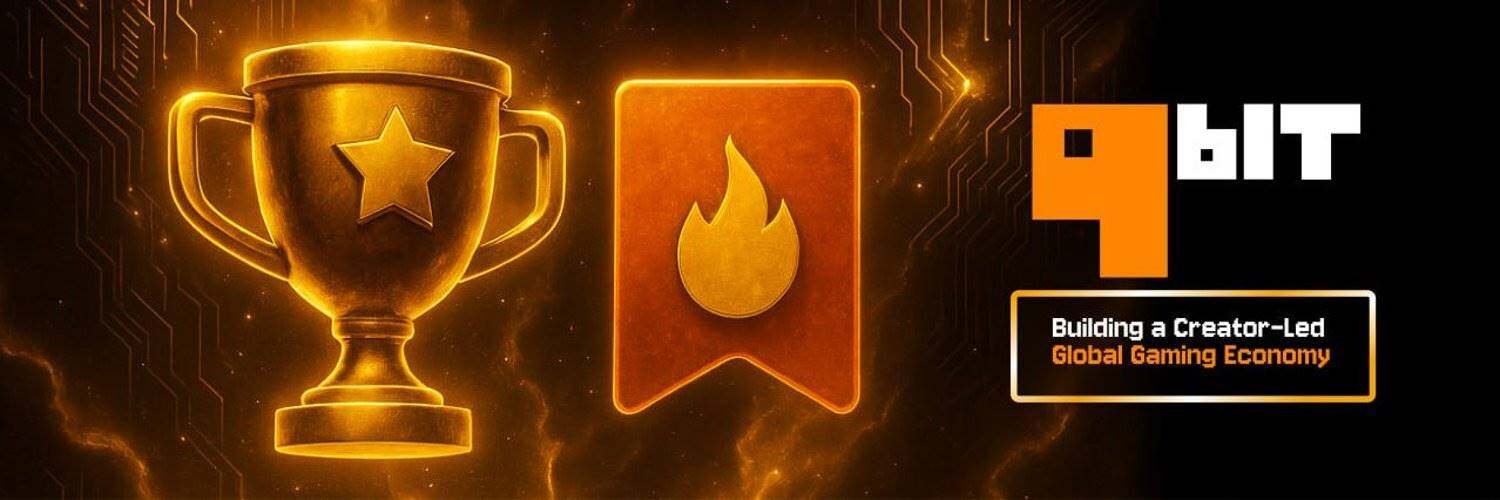
From 2005 to 2009, The9 dominated the Chinese gaming industry, with World of Warcraft bringing it annual revenue exceeding 2 billion RMB. After losing World of Warcraft, The9 experienced several ups and downs, attempting in-house development, agency services, and mining, but none of them could recapture its former glory.
Until 2025, they launched 9BIT. This time, Jiucheng no longer wanted to be an agent, but to become a rewriter of the game value distribution rules.
9BIT's core logic transforms real game consumption into investment
To understand what 9BIT is doing, you must first look at the current situation of Steam, the most successful gaming platform outside the industry.
Steam's problem is actually very simple: the one-way distribution of value.
Every year, players around the world spend tens of billions of dollars on Steam. They buy games, top up their accounts, and purchase DLC, but once they spend the money, they can never get it back.
Reviews contributed by players help games sell better, MODs extend the life of the game, and the communities formed maintain the popularity of the game, but these soft value creations are completely free of charge.
What if every purchase is not just consumption, but an investment? This is what 9BIT is doing.
9BIT's answer is "consumption is mining." This concept sounds very Web3, but the actual experience is very Web2.
When you open 9BIT’s official website, the first thing you see is not the inducement of various blockchain games to make money, but familiar 3A games, such as Street Fighter 6, Resident Evil, Monster Hunter and other Capcom masterpieces.
You can purchase these masterpieces directly on 9BIT and play them. The registration process is also surprisingly simple, just enter your email address and set a password to complete it.
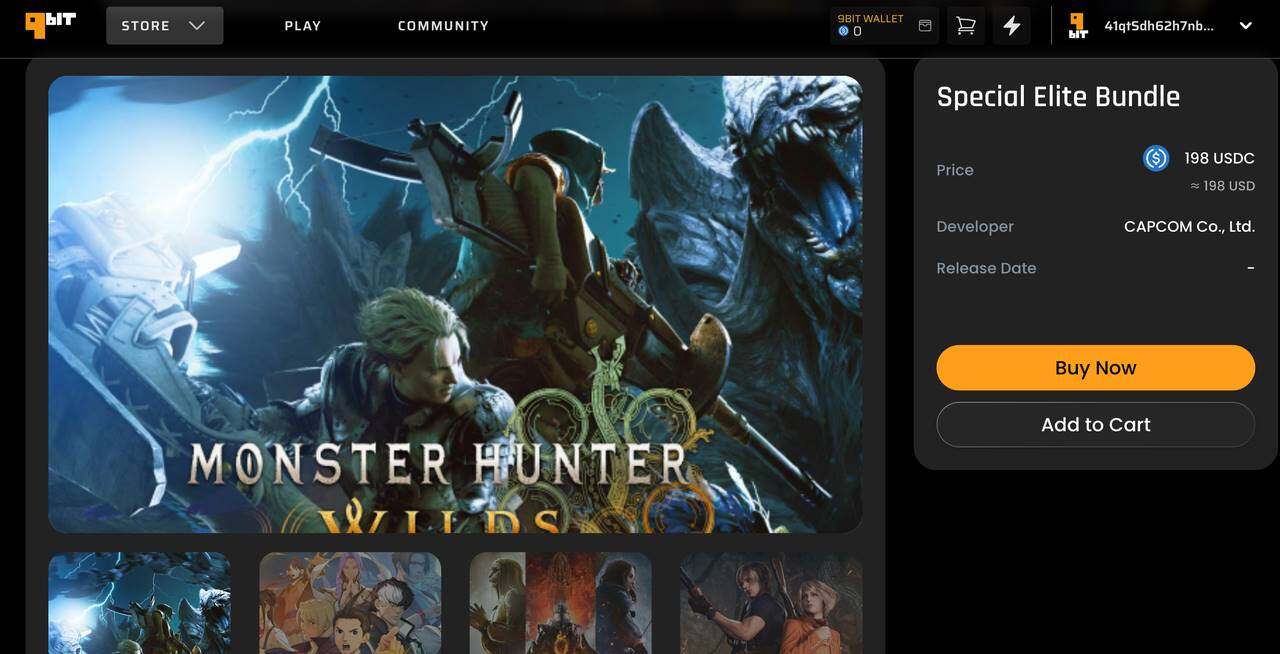
There are no mnemonics or complicated wallet setup. The system automatically generates a wallet in the background through the Particle Network, but users are completely unaware of these technical details.
This experience is actually not much different from registering a Steam account to buy games.
When you choose to purchase a game, payment options include cryptocurrencies such as USDC and traditional credit cards.
Choose USDC to pay, and the entire process is as smooth as shopping on any e-commerce platform. After the payment is successful, you will receive a string of game activation codes, which can be activated on Steam or Epic to play.
Here you can see the cleverness of 9BIT. They are not trying to be another Steam, but to be Steam’s encrypted payment layer and incentive layer:
Players still play games on the familiar platform; 9BIT simply adds extra value to the payment process. The added points in the account are a reflection of this extra value.
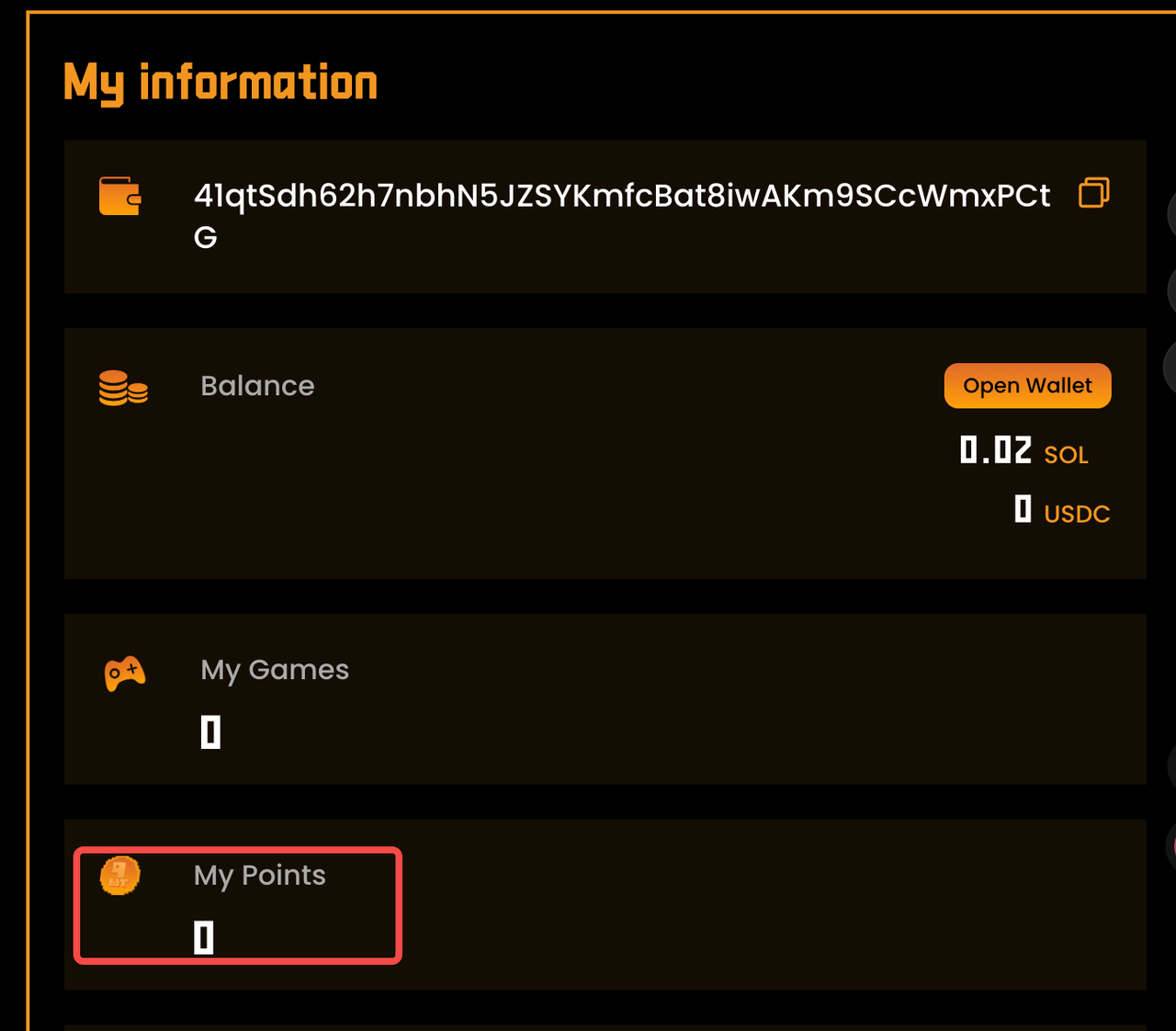
Let’s take a more specific example.
When you recharge 648 yuan for Genshin Impact, through traditional channels, this 648 yuan will buy 6480 original stones, and the transaction is completed.
But in 9BIT, in addition to the raw stones, your account will also increase corresponding points.
When you share a guide in the community and help other players clear a level, this contribution will also be converted into points. These points are a quantitative reflection of your contribution to the platform.
Naturally, points also correspond to 9BIT tokens.
Public information indicates that the ability to redeem points for 9BIT tokens will launch in Q4, coinciding with the token's listing. The project's white paper indicates that the exchange rate will not be fixed, but will be adjusted dynamically based on market conditions, thus avoiding distortions in the economic system.
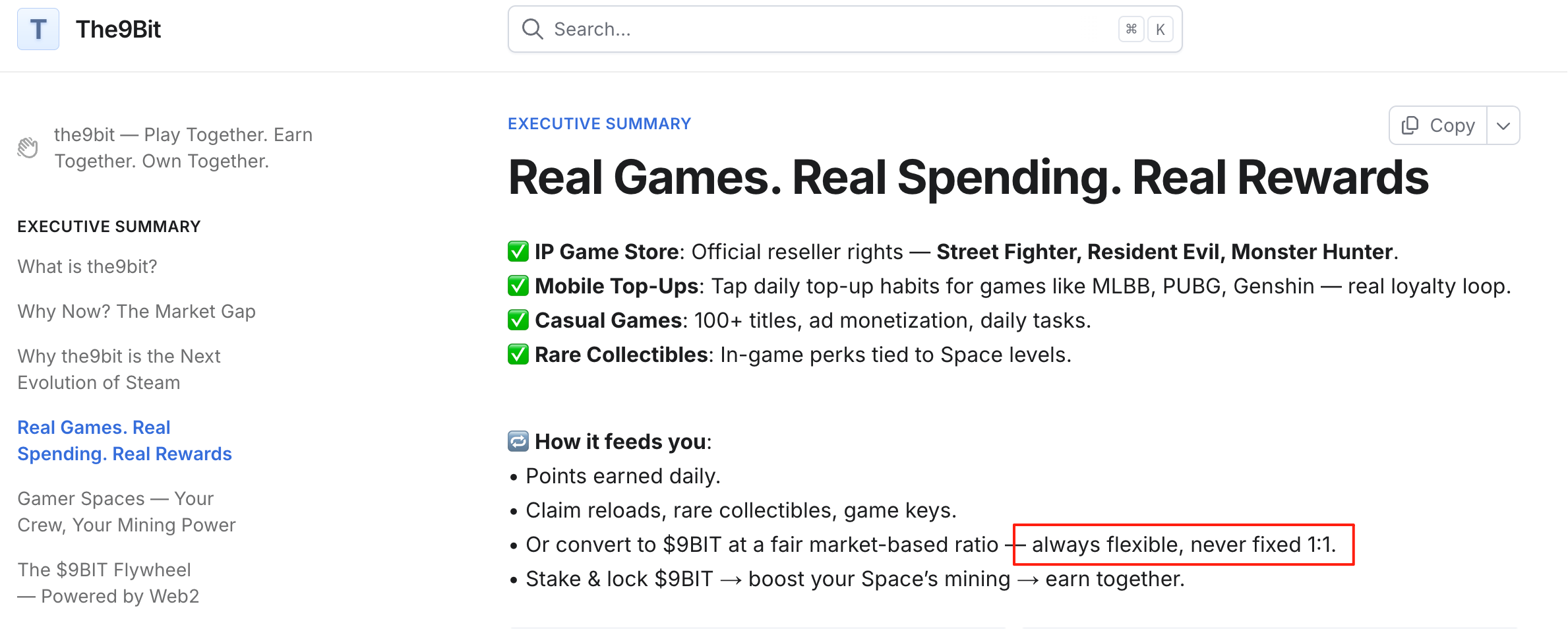
More importantly, points can be exchanged for more than just tokens.
You can use them to redeem game props, recharge vouchers, and even limited edition collectibles. Non-speculative pure players who don't want to touch cryptocurrencies can also benefit from this system.
This brings up the essential difference between 9BIT and traditional GameFi.
Traditional Play-to-Earn requires you to pay money to buy NFTs or stake tokens first, which essentially means you invest first and then get your money back;
9BIT users already need to buy games and recharge, which are essential consumption needs. Points and tokens are just additional rewards.
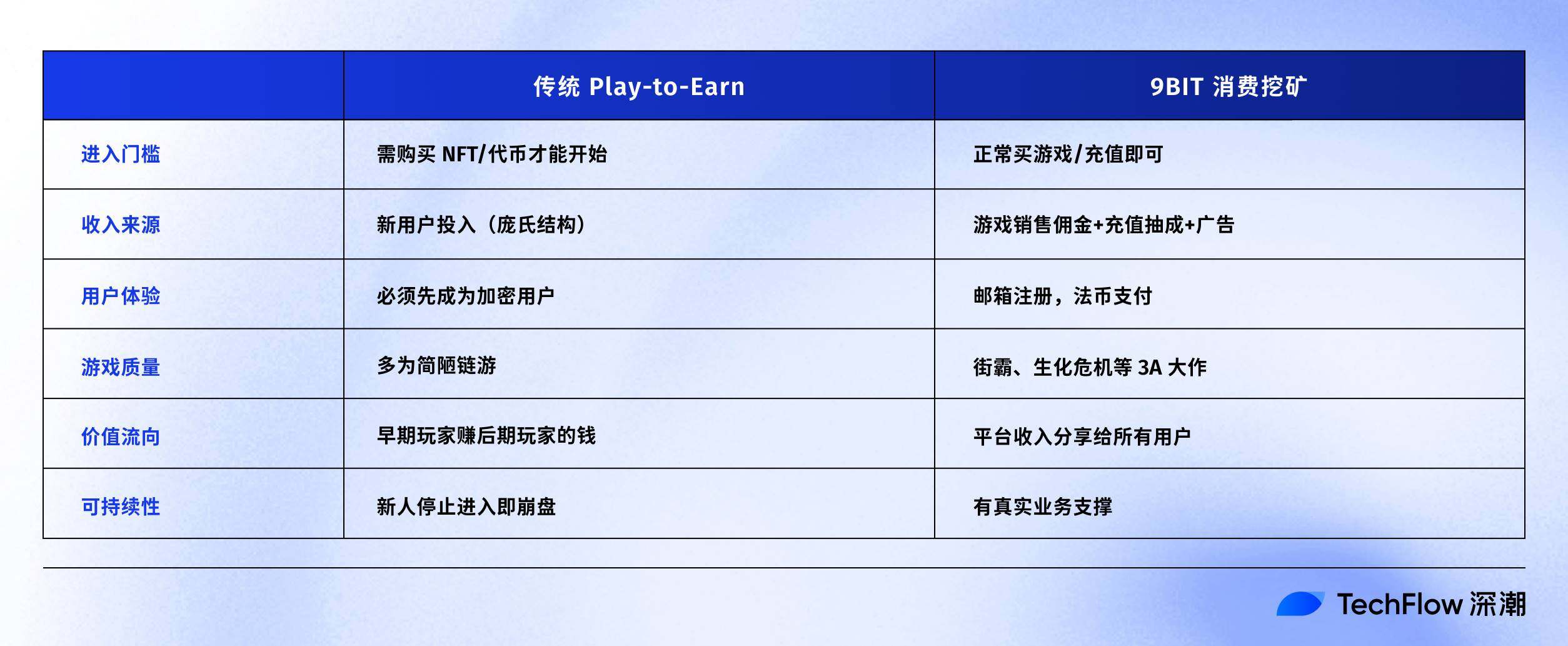
The most critical difference lies in the flow of value.
Traditional P2E is a zero-sum game: early adopters profit at the expense of later adopters. 9BIT is a positive-sum game: the platform shares the profits it earns from game publishers with contributing users. This isn't a one-way transfer, but rather a genuine external input of value.
But since we are talking about income, the next question we are concerned about is:
How real are 9BIT's so-called "real income"? Can the scale support a token economy?
Seeking a Real Revenue Moat in Game Distribution
To be honest, when people mention GameFi now, their first reaction is often to turn around and leave.
The reflexive rejection is completely understandable. After all, most blockchain games have no positive externalities and revenue sources, and rely entirely on the funds of new entrants to maintain payments to early players, which is a Ponzi structure.
So when 9BIT claims to be different, suspicion is inevitable. What is the difference? Where does the money come from?
We can do some calculations.
First, there is the commission from game sales.
On the 9BIT platform, a "Resident Evil Bundle" costs $89 and includes remakes of Resident Evil 2 to 4.
According to the game industry's distribution rules, platform operators typically receive a 10-15% commission. A simple calculation shows that 9BIT earns $8 to $13 for each game sold.
This doesn't sound like much, but considering that Capcom's game sales in fiscal year 2024 exceeded $360 million, if 9BIT can take over 1% of those sales, which is not a high goal in the distribution channel, then the annual revenue could theoretically reach $3.6 million.
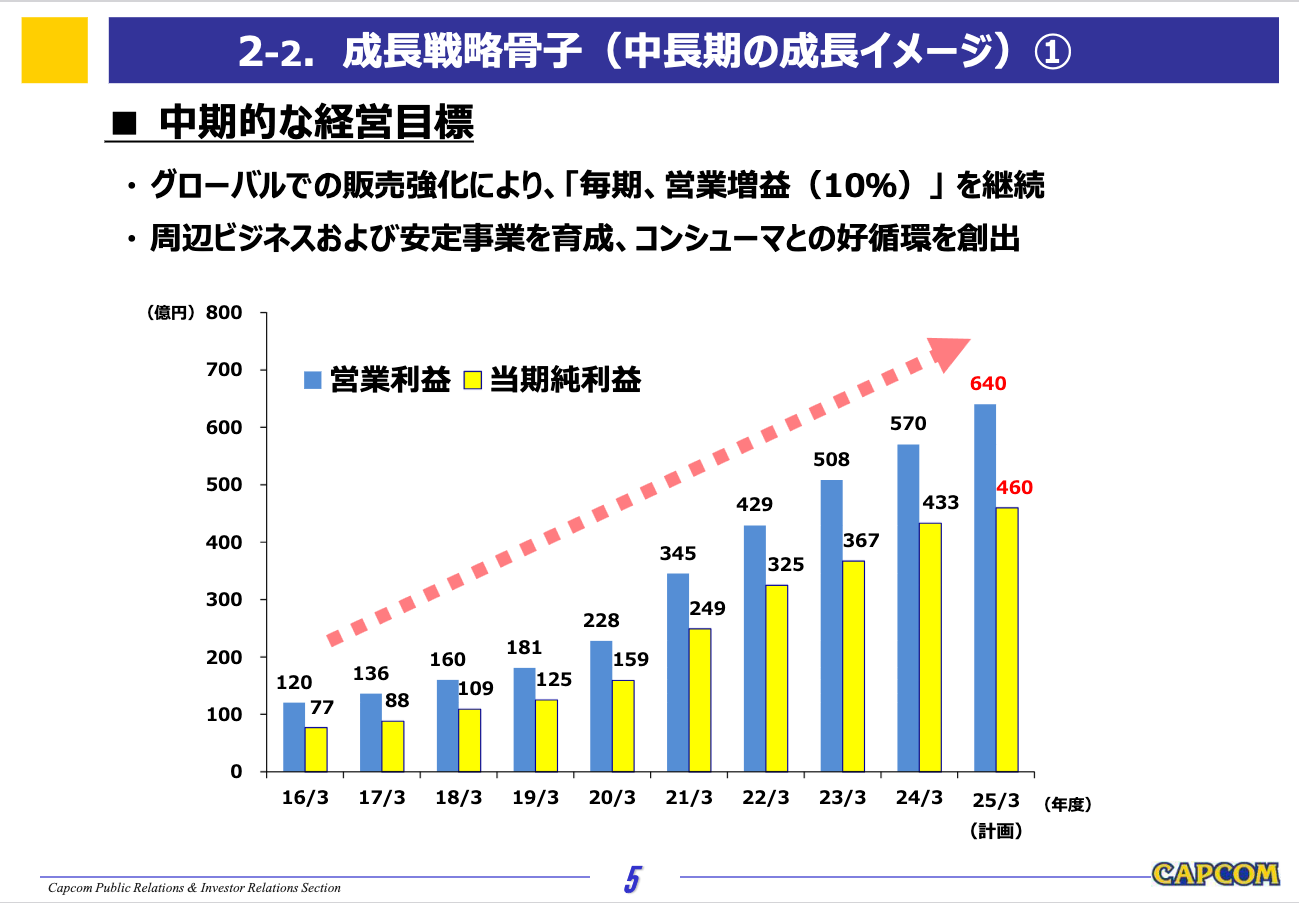
Capcom is just a game publisher. If it can connect with more publishers and major IPs, this number may increase.
The second source of income is more interesting, which is the commission from mobile game recharges.
Southeast Asia leads the world in mobile game spending. For example, Genshin Impact consistently generates over $20 million in monthly revenue in Southeast Asia. The spending on nationally recognized mobile games like Mobile Legends and PUBG Mobile is even more astonishing.
As a recharge channel provider, 9BIT usually receives a 5-10% channel fee.
A key detail is that 9BIT's partner, Vocagame, is one of Southeast Asia's largest game recharge platforms. This means that 9BIT isn't building a recharge channel from scratch, but rather adding a Web3 incentive layer to a mature traditional business.
If an active community of 1,000 people tops up $20 per person per month, the channel's monthly revenue can reach $1,000 to $2,000. Expanding to dozens or even hundreds of such communities, the revenue scale is considerable.
The third part is advertising revenue.
The platform has launched over 50 casual games, all of which are simple and easy to play. These games can use the classic incentive video advertising model, where players can watch ads to get in-game rewards.
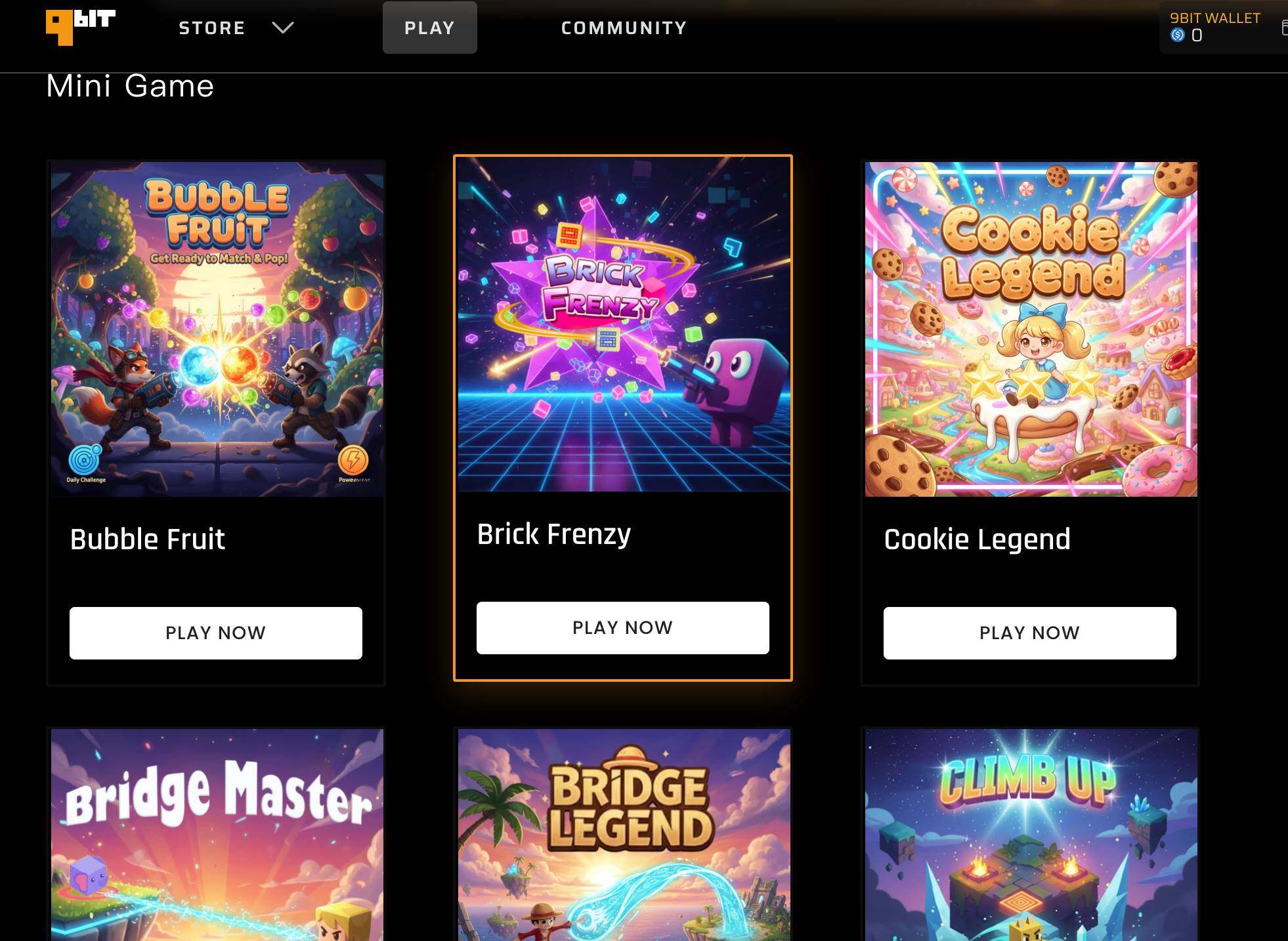
These are 9BIT's known businesses. According to plans, the P2P gaming item trading market, which will launch in Q4 and reference OpenSea's 2.5% fee, will be another source of revenue. Management fees for token staking pools and sponsorship fees for esports events are also in the works.
According to the team’s latest public data, the platform was launched on August 1 this year and currently has more than 5 million registered users, generating more than US$1.8 million in revenue.
This figure is not shocking, but the key lies in the source of this money:
This isn't a token pre-sale or NFT issuance, but actual game purchases and top-ups. In contrast, most GameFi projects had zero revenue before the token launch, relying entirely on VC funding.
It is worth mentioning that as a Nasdaq-listed company, 9BIT’s financial data will eventually be reflected in The9’s quarterly financial reports; this kind of transparency is not common in the Web3 world.
What’s more important is the sustainability of revenue. Even if the price of 9BIT tokens plummets, players will still buy games and top up their accounts, and these businesses will not disappear.
Players come to the platform for games, not for "digging, withdrawing and selling", which determines that the user life cycle will be longer.
Ideally, as the platform's game library expands and its user base grows, the network effect will make 9BIT increasingly attractive to game publishers, forming a positive cycle.
Spaces: The community is the “mining pool”
With real income as a basis, the next question is naturally: how to let contributing users share this income fairly?
Behind every successful game, there's an active Discord server where hundreds of thousands of people gather to discuss strategies, share experiences, and organize events.
But apart from occasional thanks and the title of "community contributor" that only a few people can get, enthusiastic players in the community may get nothing.
This is the norm across the gaming industry: the community creates value, and the platform reaps the benefits. 9BIT's Spaces feature appears to be changing this logic.
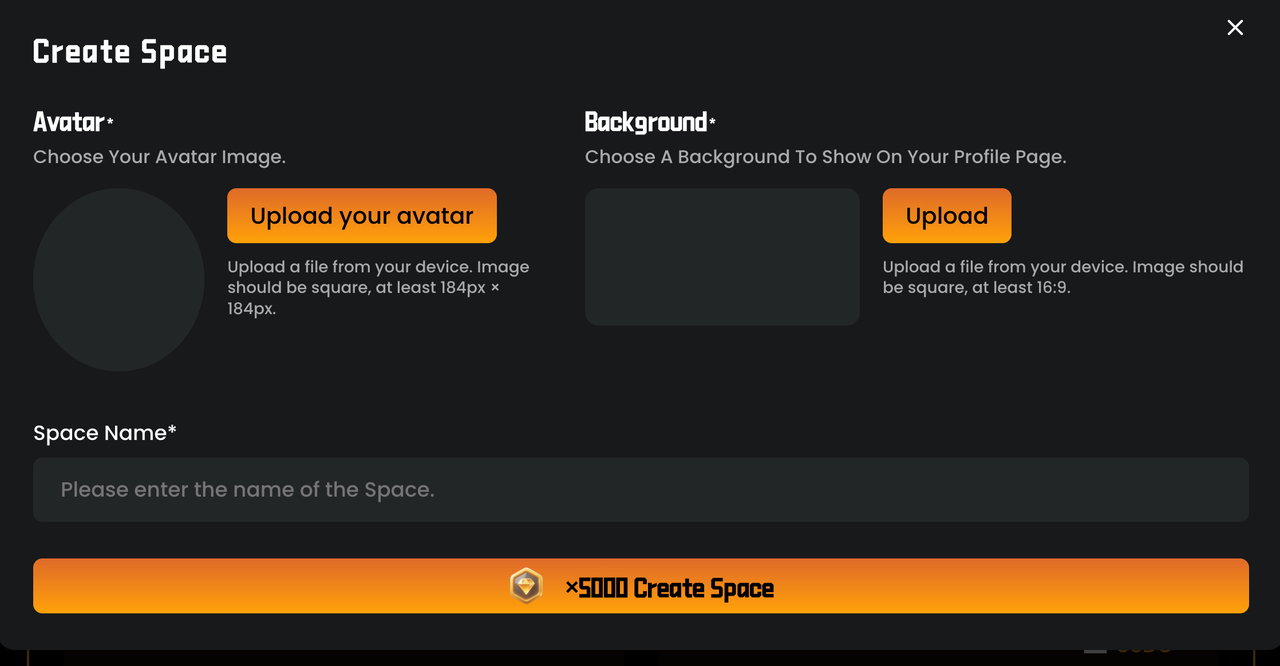
Spaces may look like Discord, but they're not exactly the same. Each Space is like a small economy where members aren't just chatting, but working together towards a quantifiable goal: mining revenue.
The mechanism is actually not complicated. The entire network releases a fixed number of 9BIT tokens every day, for example, 100,000. All Spaces are allocated tokens in this pool based on their performance.
As per the white paper, 50% of the mined tokens are immediately available for withdrawal, while the other 50% are locked for 12 months. This provides immediate incentives, allowing contributors to see returns immediately, while also avoiding massive selling pressure.
It’s also easy to see the difference between this gameplay and traditional blockchain game guilds and Web2 game communities:

This design solves the two most troublesome problems of Web3 projects.
The first is customer acquisition costs. Traditional projects spend a fortune acquiring users, using various airdrops and subsidies, but when the money is burned, the users leave. 9BIT doesn't require this. Each Space will spontaneously attract new users, because the more active and engaged users, the higher the mining returns, creating a more self-sustaining growth mechanism.
The second is user stickiness. Players join Space not only to find gaming partners, but also for common economic benefits.
Over time, top-level Spaces may generate premiums like brands. For example, being a member of XX Space will become a form of identity recognition, and there will also be room for the operation of assets such as NFTs.
Of course, I think this system also has challenges.
Preventing fraudulent transactions, balancing the interests of large and small Spaces, and ensuring long-term incentive effects are all practical issues that 9BIT has to face.
But at least, 9BIT has proposed a feasible direction to make community contributions quantifiable, incentivized and sustainable.
$9BIT Token Economy
Whether the token distribution is reasonable, whether the unlocking is restrained, and whether the value capture is real, these details hide the true intentions of the project party.
The total amount of 9BIT is 10 billion, deployed on the Solana chain, and adopts the SPL-20 standard.
The choice of Solana over Ethereum is obviously based on transaction costs and speed.
In terms of the distribution structure, 35% is allocated to ecological incentives, which is the source of all mining rewards. 43% goes into the treasury, 15% is used for liquidity, and 7% is given to the team and advisors.
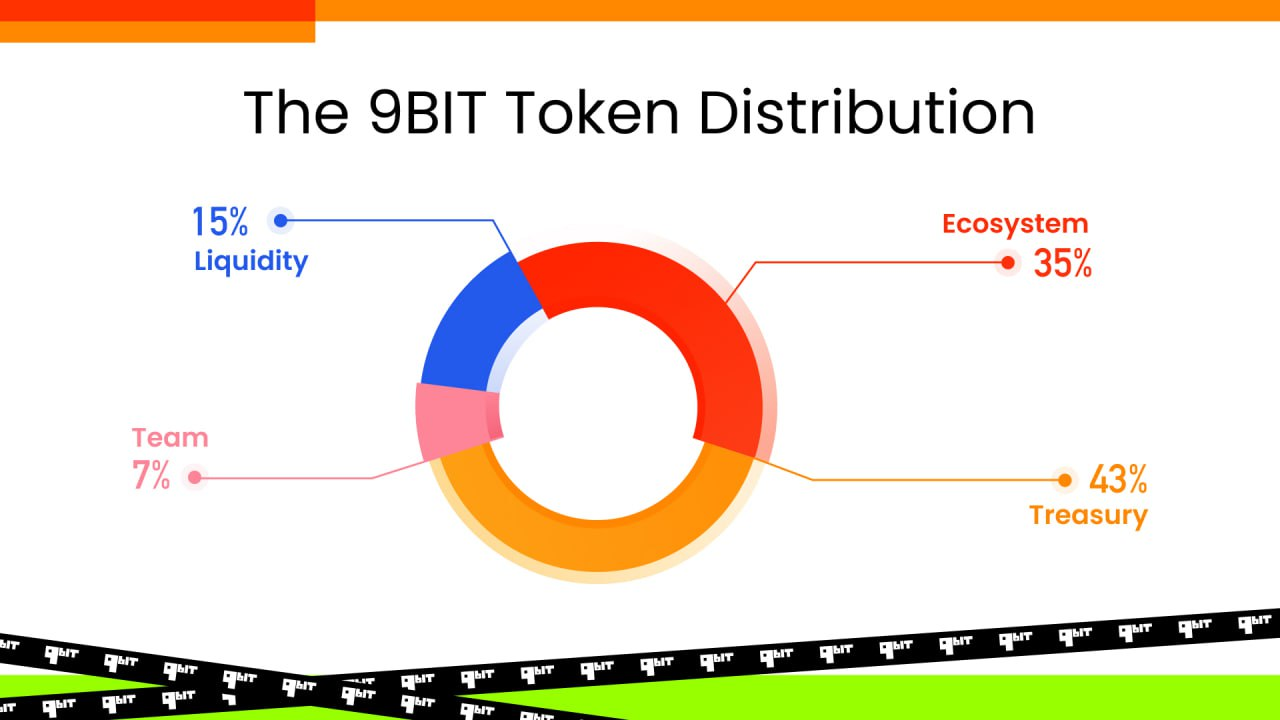
This allocation has several highlights. First, the community's share of the total, 35% of ecological incentives plus 15% of liquidity, adds up to 50% of the total.
In the case of the GameFi project, this ratio is considered generous. Many projects distribute most of their tokens to VCs and teams, leaving less than 30% for the community.
The 43% of the treasury warrants closer analysis. Of this, 19% belongs to The9, another 19% is allocated to major cryptocurrency investment institutions, and the remaining 5% is reserved for future partnerships and strategic acquisitions.
The 19% held by The9 is particularly special.
As a Nasdaq-listed company, these tokens are reflected as assets in its financial statements. This means that any large-scale sell-offs must be disclosed in advance and subject to scrutiny by the SEC and investors. In some ways, this 19% may be the most stable portion of the circulating stock.
Although this is not DAT (encrypted treasury gameplay), it also provides a ballast for a Web3 game project.
Looking further at the unlocking mechanism, the ecological incentive part will theoretically be released in 4 years, but there is an upper limit on the daily release amount, and in reality it is difficult to reach this upper limit every day.
This means that 35% of the ecological incentives may take 6 to 8 years to be fully released, which is obviously much healthier than those projects that release a large number of tokens at one time.
In addition, both the team and investors’ tokens have a lock-up period of 12 to 24 months, which is quite restrained in the current market environment.
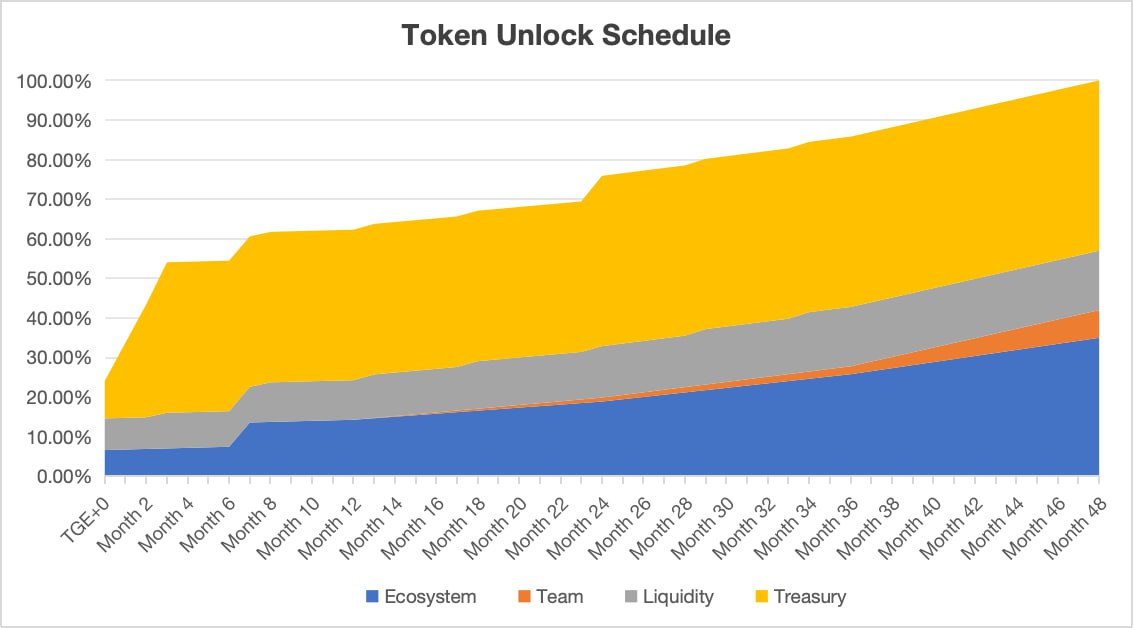
Many projects unlock a large amount of tokens on the day of their TGE (Token Generation Event), resulting in a peak at the opening and a continuous decline. 9BIT, at least in this regard, has demonstrated a long-term perspective.
Finally, let’s take a look at the value capture of tokens.
According to the white paper, the platform promises to use part of its annual net profit to repurchase 9BIT tokens.
Note that this is net profit, not revenue. This means that repurchases will only occur when the platform actually makes money.
This is far more practical than projects that rely on printing money for buybacks. A portion of the repurchased tokens will be destroyed, directly reducing the circulating supply; the remaining portion will go into the ecosystem fund for future development. In the long run, this is a deflationary mechanism.
In terms of usage scenarios, 9BIT is not a governance token that can only be used for voting.
You can use it to buy games and get discounts; staking it can improve the mining efficiency of your Space; holding a certain amount can allow you to participate in exclusive activities of the platform and even have the opportunity to buy The9 shares.
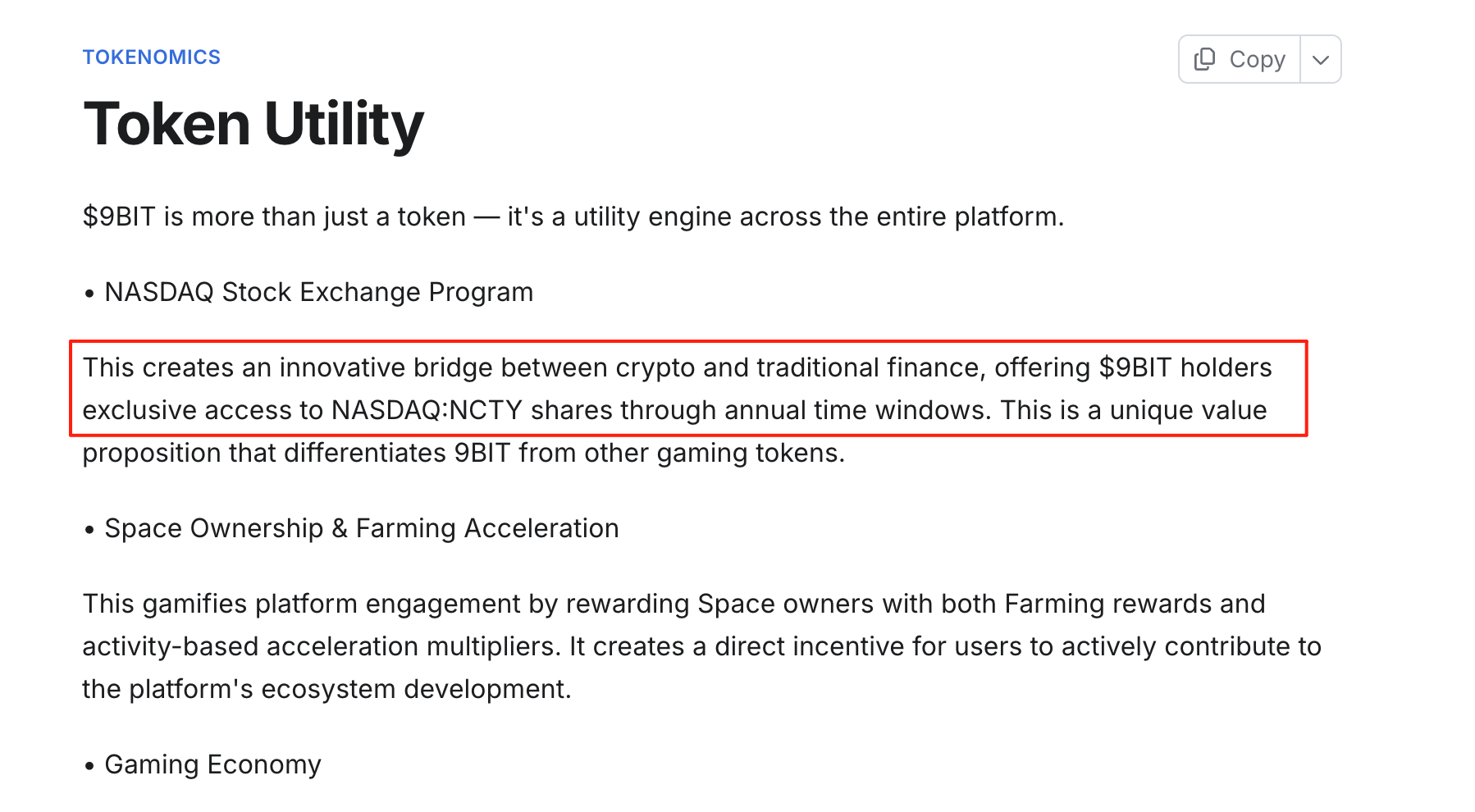
At least from the design perspective, 9BIT demonstrates the thinking of a mature team.
There are no extravagant promises, no obvious Ponzi scheme features, but rather value support based on real business and a relatively reasonable distribution mechanism.
Return to the essence of the game
After going around in circles, we finally have to return to the original question: To whom should the value created by the gaming industry belong?
Steam uses the most traditional centralized approach to prove that a game distribution platform can become a multi-billion dollar business.
9BIT is not intended to replace Steam, but rather to add a Web3 distribution mechanism to Steam's proven model. Players still play games on the familiar platform, but now they can gain a portion of the platform's ownership with every purchase.
They don't seem to be telling narratives, but rather doing very traditional business: selling real games, serving real players, and making real money.
At a time when the GameFi project is on the brink of collapse, this model based on real business seems unique.
The market environment is indeed full of uncertainty, but this is actually an opportunity for 9BIT. When the entire GameFi industry is reflecting and adjusting, truly valuable projects are more likely to stand out. 9BIT's model based on real revenue gives it the ability to navigate cycles.
What is the essence of games? It's fun, social interaction, and a sense of accomplishment. But in the Web3 era, games can also be an investment, a form of equity, and an opportunity for shared growth.
What 9BIT wants to do is to make players the real beneficiaries without changing the essence of the game.
From the agent of "World of Warcraft" to the pioneer of Web3 game platform, Jiucheng has gone through a cycle in 20 years.
This time, as more and more people realize that the value they create should be rewarded, 9BIT has prepared new answers for them.
This is a new chapter in the gaming industry and the beginning of 3 billion players becoming "shareholders".

